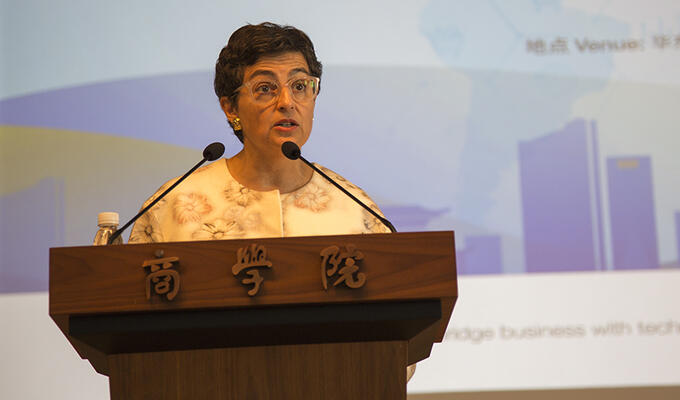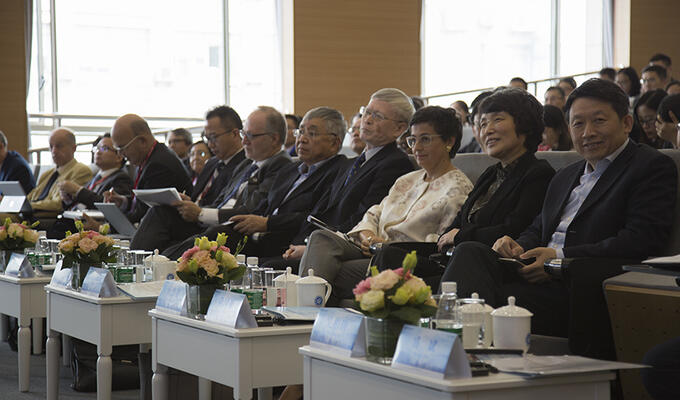

ITC Executive Director: global markets key to China’s development success (en)
East China University of Science and Technology (ECUST)
Forty years ago, in December 1978, Deng Xiaoping made a decision that changed the course of history and went on to alter the lives of over a billion people. The Reform and Opening-up started in 1978 put China on the path of market economic reforms and opened the country to global trade and investment.
Today, China is the second largest economy and the largest trading nation. More than 800 million people have been lifted out of poverty, per capita GDP has risen from $180 to nearly $9,000, and a broad spectrum of industries have been developed.
China’s return to a leading place in the global economy has been accompanied, albeit less dramatically, by other developing countries. Between 1980 and 2011, developing economies raised their share in world exports from 34 per cent to 47 per cent. Their share in world imports rose from 29 per cent to 42 per cent.
Trade has been at the center of China’s epic transformation of the past four decades. Trade attracted investment, created jobs and built up industries. Through trade, China used global market demand to pull people and resources out of subsistence activities and into more productive work. Trade allowed China to import what the world knew and export what the world wanted. Exporting served as a source of discipline for Chinese firms: inefficient, unprofitable firms cannot compete on world markets.
China’s experiences clearly shows that open trade and investment can be a powerful tool to achieve growth and development. China’s future success also depends on a continued effort to ensure even more open markets and competition, as well as even further deepening reforms.
The numbers for the past four decades speak for themselves: economic growth was fastest when the Reform and Opening-up moved forward and the slowest when China stopped or backtracked on this path.
The challenges that China faces today may be more complex, but they are not necessarily more difficult. There have been times when the country was facing greater internal and external challenges. But China managed to deal with them and kept on going. I hope that China will continue its effort towards market-oriented reforms, in particular for its state-owned enterprises sector, further open its markets and play a more active role in contributing to global prosperity and the UN’s Sustainable Development Goals.
Ensuring that global trade works for all
Global trade has been safeguarded by multilateral trade rules in the past decades. But now multilateralism is facing headwinds. Rising geopolitical tensions risk disrupting trade and investment flows. What can we do to ensure that trade, investment and new technologies contribute to sustainable and inclusive global growth?
First, we need to defend the rules-based multilateral trade system. Getting rid of the system is not the answer to today’s trade tensions. Instead of raising barriers to trade, which hurts countries’ own competitiveness, they should invest in reforming global trade rules. The WTO rulebook had its last full update in 1995, long before the technology revolution. A technology-related trade agenda could better define parameters for trade in the 21stcentury. New topics such as e-commerce and digital trade, investment facilitation, domestic regulation, MSMEs are among the topics now being discussed at the WTO. I hope China will step up its support to the multilateral system, and work together with the WTO members to produce meaningful results in updating the rulebook of the multilateral trade system.
My second point is related to the first. The trade tensions we see today are a symptom of rising geopolitical competition, notably between the United States and China. The question is whether these geopolitical tensions will destroy the multilateral trading system, or whether we will be able to update and use multilateral institutions like the WTO to mediate and cooperatively manage shifts in economic and political clout. The first option would damage growth prospects in all countries. The second option would support collective prosperity.
This is why key players in the international trade arena need to work together to resolve escalating trade tensions. Viewed from here in Shanghai, one of the priorities should be to ensure that trade tensions should not spread to China’s trade with other countries. In this sense, China is making the right move to reduce tariffs staring from November and to increase imports. This will shield Chinese consumers from rising prices and help Chinese producers maintain access to imported materials and components.
Third and finally, we should make trade work for all, not just the 1%. Benefits from trade should reach everyone, including women, young people, and the poor, and not just for the CEOs and investors. Small and medium-sized enterprises (SMEs) employ the vast majority of people. Wages paid by SMEs are a big part of whether people share – or do not share – in the gains from growth and trade. This is why ITC is focused on helping SMEs in developing countries to internationalize and increase their competitiveness in the global market.
As we have seen, developing countries have substantially increased their share of global trade. But there is still room to improve. South-South trade has quintupled in the last 20 years, and now accounts for almost 30% of global trade.
Demand from elsewhere in the South will help other developing countries emulate China’s trade-led success. China is a significant market for companies from the developing countries. Through the Import Expo, I hope more companies from the developing countries can explore the Chinese market and do business with their Chinese counterparts.
Import Expo
Traditional trade fairs are about exports. CIIE is about imports. This signals China’s commitment to increase imports and keep its doors open.
It also reflects that China understands the importance of imports. The traditional mercantilist view that exports are good and imports are bad was outdated even in the 18th century. In today's world, it is particularly misguided. Production today is organized through global and regional value chains, where imported inputs are needed and in fact critical for export competitiveness. In computers and electronics, one of China's largest export sector, foreign value added, that is imported parts and components, account for over half of total value of export.
CIIE also signals that China is shifting from the "world's factory" to the "world's market", placing more importance on meeting the increasing demand of consumers for more and better products and services. In this transition, China could share many opportunities, by importing more products and services, by sharing knowledge and technologies, and by investing in sustainable development in developing countries.
This is why ITC is partnering with the Import Expo and why we are supporting 100 SMEs from developing countries to participate in this first international import expo. We’re not only supporting their participation, but also prepare them for better understanding the Chinese market, understanding trade regulations, and helping them to connect to potential buyers.
The Import Expo is also a space for dialogue to promote mutual understanding and cooperation – both of which are urgently needed at this time.
We’ll be hearing from state leaders and experts about how they see the state of global trade and its future. I’ll be moderating a session tomorrow afternoon on trade and investment at the Expo’s Hongqiao Forum and I’m sure the views and suggestions from the session will help us better navigate through the challenges we face today.
Thank you and I wish the 1stInternational Forum on Chinese Import a great success.



